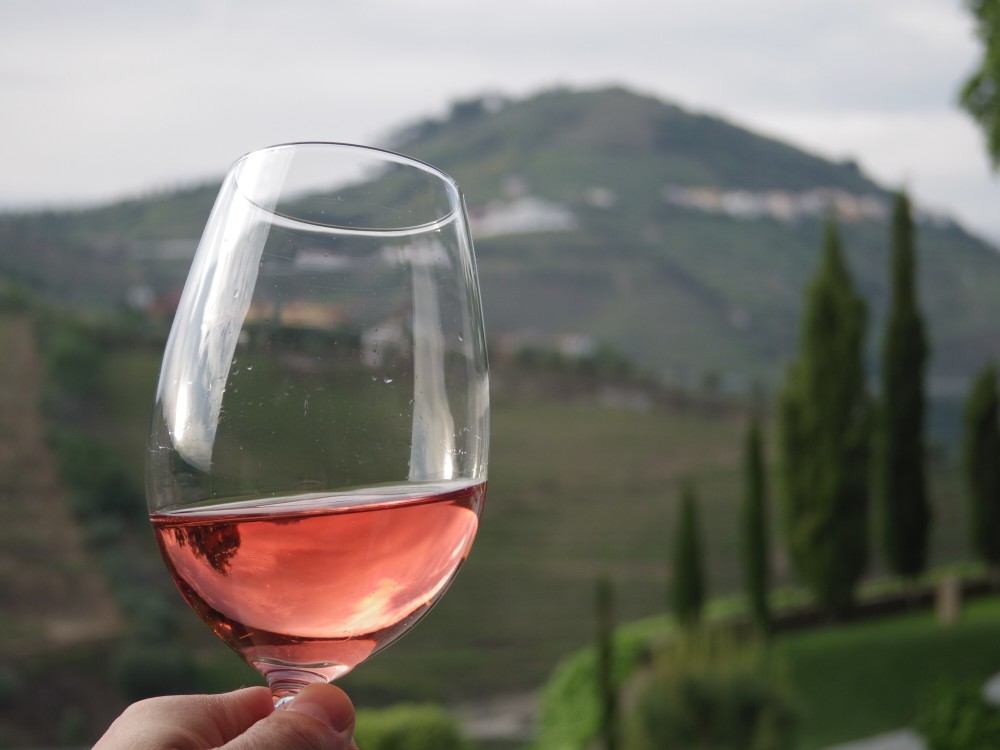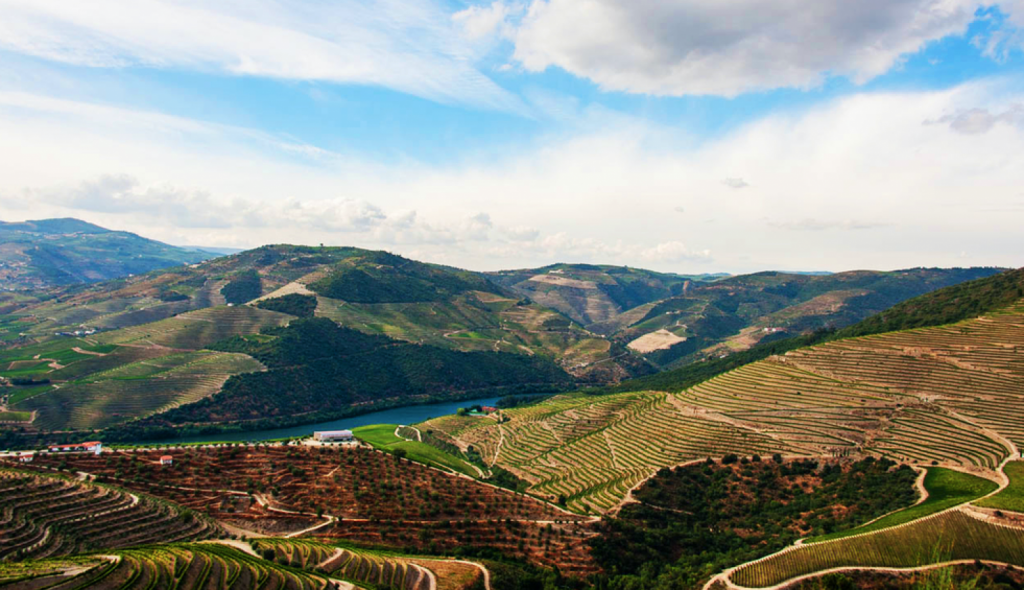An in-depth breakdown of Portuguese wines and culture
[dropcap letter=”V”]arietals of wine grapes are endless: Chardonnay, sauvignon blanc, pinot noir, merlot, cabernet sauvignon, riesling, malbec, barbera, Nebbiolo, sangiovese, pinot grigio … and more! There are hundreds upon hundreds of wine grapes grown throughout the world. Most of those we’re familiar with come French or Italian grapes but have you ever heard of alvarinho, verdelho, malvasia, alicante, tinta roriz or touriga nacional? If not, we wanted to introduce you to some Portuguese wines making their way to more and more on wine lists at some of your favorite restaurants and wine bars.
About the Region
Portugal is located in the Iberian Peninsula in the southwest of Europe, bordered by Spain on one side and water on the other. It’s a small country, only 35,645 square miles (575 miles long by 138 miles wide), which makes it the same size as the states of Maine or Montana. That said, while Portugal may not be a big country, it has the ninth largest vineyard area in the world in comparison to the United States, which ranks sixth.
Portugal is the ninth largest exporter to the United States, behind France, Italy, Spain, Chile, Australia, New Zealand, Argentina and Germany. Twenty-five percent of what is exported are delicious fortified wines, Madeira and Port and seventy-five percent of the wine exported to the US from Portugal are still, dry wines.
[separator type=”thin”]Portuguese Wines 101
Portugal is home to 250 indigenous grape varieties! This is the highest density of indigenous varieties in any country (even more than Italy) but with diversity, comes confusion. The amount of varietals to learn about can often seem daunting. Learning about the regions, how to pronounce them, how to pair them can seem like a painstaking process but I think the easiest way to learn about them is to learn what family of grapes and wine varietals they are similar to.
Of the 250 grape varietals in Portugal, there are 34 that are the most planted, 18 of which are red and 16 of which are white. Comprising a list of twelve of these grapes, the below are those you are most likely to find in wine stores you shop at or on wine lists at restaurants or wine bars you frequent. Now you can add a few more impressive wine facts to your repertoire of sipping tidbits and hopefully introduce your palate to something new …

WHITE WINES
Alvarinho (ahl-vah-REEN-yoh)
Alvarinho is a grape planted in the regions of Vinhos Verdes, Alentejo, Dão, Setúbal and Lisbon. It is a wine that tends to be low in alcohol and high in acidity. It’s typically an un-oaked wine and has notes of honeysuckle, peach, lemon, grapefruit, apple, green pineapple and minerals. Over time, as the wine ages, it will develop notes of honey.
You will like alvarinho if you like: albariño, pinot grigio or dry riesling.
Arinto (ah-RIHN-toh)
Arinto is grown in Vinho Verde and is one of the grapes found in the blend of Vinho Verde wines. It produces a delicate wine with acidity and has the capacity to age. On its own, the wine has notes of lemon, green apple, lime, citrus blossom, stones and verbena.
You will like arinto if you like: dry riesling, pinot grigio or pinot blanc.
Bical (BEE-cal)
Bical is found in the regions of Bairrada, Dão, Douro and Tavora Varosa. It is an aromatic wine that grows best on calcerous soils. It is soft, fresh and well-structured and has notes of cantaloupe, peach, light tropical fruits, citron, cherimoya, golden apple and unripe apricot. This is a grape that can handle time in oak.
You will like Bical if you like: dry riesling, ripe gruner veltiner or ripe albariño.
Gouveio (Goo-VAY-oh)
Gouveio is grow in the Douro and Trás-os-Montes regions and is a wine with low alcohol and high acidity. The wines are fresh and lively with notes of peaches, tangerines, yellow apple, stony minerality, anise, celery root and tarragon.
You will like gouveio if you like: marsanne, Semillon or grenache blanc.
Malvasia Fina (Mahl-va-Zeya Fee-nuh)
Malvasia Fina is gown in northern inland Portugal, especially in the Douro, Dão and Beira Interio, as well as in the Tavora-Varosa, Lisbon and Madeira (where it is called boal). A subtle wine, it is not intense, reasonably fresh and often used in blends, including sparkling wines. On the nose, you will find green banana, jicama, white fig, beeswax, light molasses and meyer lemon zest.
You will like malvasia fina if you like: semillon, roussanne, or pinot blanc.
Verdelho (Ver-DEL-yo)
Verdelho is found in Madeira, Azores DOC, Alentejo, Douro and Setúbal. It is a great wine for fortification and can range from dry to off-dry. It will have aromas of fresh peaches, tangerine and herbal notes.
You will like Verdelho if you like: verdejo, ripe sauvignon blanc, vernaccia, fortified vin jaune or sherry.

RED WINE
Alicante Bouschet (Ah-Lee-CAN-tay Boo-SHAY)
Alicante Bouschet is grown in Alentejo, a region that covers two-thirds of Portugal. The wine is a full bodied dry red wine with a lot of tannin and grip. It has aromas of blackberry, black cherry, blueberry, red/black plum, red/black currant, bitter, chocolate, smoke, carob, coffee, leather and pepper.
You will like Alicante bouschet if you like: petite sirah, sangiovese grosso or zinfandel field blends.
Baga (BAH-guh)
Baga is grown primarily in Bairrada and Dão. The wines have aromas of red cherry, red/black plum, tobacco and coffee bean. The wine has a deep color, good structure, lots of acidity and powerful tannins.
You will like baga if you like: nebbiolo (from Piedmont, Italy), pinot noir or xinomavro (from Naoussa, Greece).
Castelao (Kass-tell-Ownh)
Castelao is grown in the regions of Setúbal, Alentejo, Tejo and Lisbon. It produces a rustic wine with notes of raspberry, red currant, cherry, blue floral, caper berry, cedar, game and tea leaf. It is a wine with texture and acidity without hard tannins. As it ages, the aromas evolve into cedar and cigar-box notes.
You will like castelao if you like: grenache blends, ripe cabernet franc or tempranillo/grenache blends.
Sousao (Suz-AOHN)
Sousao is grown in Vinho Verde, Douro and Lisbon. It is a highly structured wine and very dark color, due to the grape’s deeply pigmented skin color. This wine has notes of red/black cherry, tart plum, cola, rosemary, thyme and anise seed.
You will like sousao if you like: barbera (from Piedmont, Italy), xinomavro (from Naoussa, Greece) and baga.
Tinta Roriz (TEEN-tah-ROAR-eez)
Tinta roriz is grown in the Douro, Dão and Alentejo, where it is called aragones. The grape can be highly aromatic and elegant and blends well with other grape varieties. The nose is a potpourri of aromas, including ripe strawberry, plum, mulberry, herbs, fennel, leather, black pepper, licorice, tobacco, toast, vanilla and smoke.
You will like tinta roriz if you like: sangiovese or Rioja-style wines.
Touriga Nacional (Too-REE-gah Nass-eyo-nal)
Touriga Nacional is grown in the Douro, Dão, Bairrada, Alentejo and Tejo. The grape, which loves the heat, is Portugal’s most planted grape. It produces a complex wine with aromas of rose, violets, licorice, ripe black fig, black currants, berries, black plum, black red and raspberries, pine, eucalyptus, bergamot, rosemary, violets, licorice and bitter chocolate. You will like touriga nacional if you like: cabernet blends, petite sirah or full bodied syrah/shiraz.
When it’s all said and done, wine is meant to be explored and enjoyed and hopefully this A-Z guide of the grapes of Portugal will be a handy reference inspiring you – and your palate – to keep an eye out for Portuguese wines!





